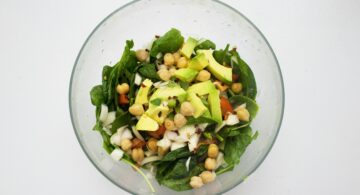How to Eat Allergy Free
The phrase, “You are what you eat,” rings true for thousands, if not millions, of people.
- For some, gluten makes their joints ache.
- Eating soy from Chinese take-out leaves many with a bloated abdomen.f
- Chemical additives in nearly every snack food give many people explosive migraines.
Your body becomes, or rather manifests, daily what you eat. You might not even realize the association; so many people live in such a constant state of discomfort, they don’t even remember what healthy feels like!
Food allergies and food sensitivities are a common culprit behind many of life’s discomforts, aches, and pains. Instead of addressing possible food allergies or intolerances, we often run to the doctor looking for a pill to fix what ails us. The problem with drugs is they rarely ever fix the root issue, which in this case is a food you’re eating.
Instead, prescriptions and OTC drugs attempt to mask symptoms… and many times don’t even work that well. Our society is constantly taking pills for symptoms of food allergies and intolerances! Just take a look at the drugs that can often be eliminated from someone’s regime just by excluding a particular food!
- Antacids
- Antidiarrheals
- Laxatives
- Anti-gas drugs
- Anti-inflammatories
- Pain killers
Many of these drugs are completely unnecessary once food allergies and sensitivities are identified and taken out of one’s diet. Once again, the pathway to healing your body is through the foods we eat…and don’t eat.
Identifying Food Allergies and Sensitivities
Like I mentioned earlier, many people have been in discomfort for so long that they don’t know what normal feels like. Living with uncontrolled symptoms of food allergies or sensitivities includes suffering with:
- Digestive issues
- Headaches
- Fatigue
- Joint pain
- Asthma
- Skin issues
- And more
These issues may ultimately stem from a food their body does not tolerate.
Food allergies are a direct immune response by IgE antibodies in our body. If these antibodies spot a particular offending food protein in the blood, then they send the body into attack mode. Symptoms can range from tingling in the mouth to anaphylactic shock.
From a conventional approach, the focus on a healthy diet is maintaining a healthy weight, avoiding fatty foods, and counting calories. However, an alternative approach focuses not only on foods that contribute to a healthy weight, but also foods that are high in nutrition and, in this case, foods that are common culprits in food allergy or sensitivity reactions in the body.
A common principle in alternative medicine is that everyone’s body is different. There is no one-size-fits-all healthy diet. What works well for one person, can be disruptive to another.
You see this principle in Ayurvedic medicine which divides people into Vata, Pitta, and Kapha types; Chinese medicine that divides people into Ying and Yang types; the Blood type diet which divides people into A, B, AB and O types; the nutritional typing diet that divides people into carbohydrate, protein, and mixed types; and the list goes on.
Food sensitivities and food allergies can be common among certain “types” of people. Differences in metabolism, blood type, and other genetic factors play a role in our body’s response to different foods.
Food allergies are often a genetic trait and can be passed down through generations. Many times if a parent has an allergy, then their child may have the allergy, as well. Sometimes it may not manifest as severely and because of this, can often go unnoticed. However, just because you don’t go into anaphylactic shock when you eat peanuts, although your father does, doesn’t mean you don’t have a peanut allergy. Your symptoms may be more mild or atypical.
Many children who have asthma or skin issues, like eczema, have a food allergy. Food allergies can worsen with age and these children often grow into adults who struggle with autoimmune diseases and extreme digestive disorders from years of chronic inflammation. Often, these people have never thought to attribute their health problems to what they are eating
Identifying possible food allergies starts by knowing the most common culprits. There are 8 foods that attribute to 90% of food allergies:
- Peanuts
- Tree nuts
- Milk
- Egg
- Wheat
- Soy
- Fish
- Shellfish
Food sensitivities, on the other hand, don’t produce the severe immune reactions that food allergies can. Though some food sensitivities can manifest mild allergic responses, most are slower to react and are not life threatening.
However, food sensitivities are far more common than food allergies. I believe this is due partially to the rise in manufactured and lab created foods. Our bodies do not process these pseudo-foods like real all-natural foods. Lab created chemicals may be disguised as food, but our bodies keenly know the difference.
GMO foods have exacerbated food intolerances, as well. Genetically modified food products have proven to cause damage to the intestinal lining, cause imbalances in gut flora, and leave chemical residues in the body.[1]
Though the following 5 foods make up the majority of food sensitivity cases, it is important to note that almost anything can be the culprit. Starting with an elimination diet is truly the best way to identify the true offender of the bloating, irritable bowel, migraines, headaches, runny nose and general “feeling under the weather” symptoms you may have been experiencing. Excluding these foods from your diet is the best tool for determining food intolerances and sensitivities.
1. Wheat (Gluten)
Gluten intolerance has recently got enough attention that it has become trendy to go “Gluten-Free.” People are jumping on the bandwagon because gluten-free is now associated with being healthy. People just can’t deny the fact that they feel much better when they remove gluten from their diet.
It is no wonder as it is estimated that nearly 1 out of 2 people may suffer with some level of gluten intolerance.[2] This is a staggering statistic and may explain the rise in digestive disturbances, mental disorders like depression and anxiety, and attention disorders like ADD.
Gluten itself is very difficult to digest and can cause inflammation in the intestinal tract, regardless of a gluten allergy or sensitivity. Autoimmune diseases like Hashimoto’s and diabetes can also result from gliadin, a gluten protein similar in structure to some of our body’s tissues.
Most people have no idea that gluten is the culprit behind their health problems until they remove it from their diet. Removing gluten can result in surprisingly pleasant side-effects like weight loss or a reduction in pain. Thankfully, there are many gluten-free options now available at most grocery stores. However, I recommend staying away from gluten-free products that substitute with corn, as it is a high allergen food, as well.
2. Dairy
Even with the rise in gluten sensitivities, dairy still remains the most common of all food intolerances. Lactose intolerance occurs when there is a lack of the enzyme lactase, which leaves lactose sugar undigested. As a result, bacteria in the gut breaks down the lactose sugar instead, causing a plethora of digestive upsets. Although lactose intolerance is a common cause of dairy sensitivity, there are other contributors, as well.
The modern practices of pasteurization and homogenization may be contributing to dairy intolerance. Pasteurization kills the natural enzymes present in milk that help with digestion. Homogenization reduces molecules in milk to a size small enough to bypass digestion. These tiny protein molecules can end up in your bloodstream causing inflammation and increased mucus production.
- If you are dairy sensitive, then you may find that you can tolerate raw milk products because they are not pasteurized or homogenized.
- Oftentimes, cultured dairy like yogurt is better tolerated as well, because the fermentation process breaks down lactose sugar in the milk.
- Eliminating dairy is best with lactose sensitivity, but supplementing with an enzyme containing lactase can also be helpful when consuming dairy products.
3. Corn
Today’s corn isn’t what it used to be. Most corn is now genetically modified to produce it’s own pesticides in order to create higher yields. Though this may seem like a valiant endeavor…
The pesticide that GMO corn produces called Bacillus thuringiensis, or Bt, can cause allergic responses throughout the body along with a host of other potential health problems including anemia, high blood sugar, and cancer![3] It is likely this GMO corn is the reason behind the spike in corn sensitivities and other food sensitivities, as well. GMO foods can aggravate food sensitivities by causing damage to the intestinal wall and disrupting the bacterial balance in the gut.
Corn sensitivities can produce symptoms like:
- Foggy thinking
- Angry behavior
- Headaches
- And fatigue
It is hard to avoid corn because it hides in everything from ketchup to toothpaste. Look out for ingredients like high fructose corn syrup, corn oil (vegetable oil typically has corn oil), and maltodextrin. These are all corn products that people often overlook because they hide in the ingredient list.
4. Soy
Soy is another genetically modified food that causes food intolerance for many people. Soy is my #1 enemy because I suffer from severe soy sensitivity. I noticed this shortly after entering the world of natural health while drinking daily soy protein shakes. I personally suffered from extreme abdominal pain, gas, bloating, and constipation. Other symptoms of soy intolerance may include:
- Diarrhea
- Indigestion
- Skin rashes
- And headaches
Soy is a legume; therefore, it can accompany sensitivities to other legumes like beans and peanuts.
I personally don’t believe soy is fit for human consumption and it is far from a health food. It is difficult to digest, blocks the absorption of important minerals, and has hormone-like qualities. Like corn, soy is in nearly everything. Reading ingredient lists is important in eliminating soy from your diet.
5. Eggs
Eggs, the egg whites in particular, are a common food sensitivity. Egg whites contain naturally occurring enzyme inhibitors that can actually block enzymes in our digestive tract from doing their job. Undigested protein from eggs can then cause:
- Digestive disturbances (nausea, abdominal pain, vomiting or diarrhea)
- Hives or eczema
- Itchy, red, watery eyes
- Wheezing, coughing, or runny nose
- Swelling of lips, tongue, or face
- And can even leak through the gut and into the bloodstream inciting an immune response.
6. Food Additives
Food additives are used to sweeten, enhance flavor, brighten color, and extend the shelf life of nearly all processed and fast foods. Because these are not truly food, but lab manufactured chemicals, our bodies often react unpleasantly. The most common food additives include:
- Artificial Colors (Red #40 is the most allergenic)
- Artificial Flavors (MSG in particular)
- Artificial Sweeteners (aspartame, sucralose, saccharin)
- Preservatives (Nitrates, Nitrites, and Sulfides)
Many people suffer full-blown allergic reactions breaking out in hives or having asthma attacks upon ingesting different food additives. MSG is known to cause severe migraines and artificial sweeteners can even cause symptoms of MS! Even if you aren’t having any outward physical reactions to these additives, I recommend eliminating them from your diet.
The Elimination Diet
Following an elimination diet is the best way to identify which foods you may be allergic or sensitive to. Although allergy testing is available, it can often be unreliable and should always be followed with an elimination diet for confirmation. Food sensitivity testing is often inaccurate, as well. Following an elimination diet will take planning, time, and will power. However, its reliability is worth the time in identifying the root behind the discomfort you have been dealing with.
There are varying forms of the elimination diet; however, they all follow the same basic premise. In order to identify food allergies and sensitivities, you must follow this diet without cheating for 7-15 days! This is extremely important because during this time you will be cleansing the residues from the offending foods out of your body.
After the 7-15 day period, you will then begin adding back a new food every other day (if you have no reaction), and waiting a third day if you do react to a particular food. Keeping a food journal is very important. You must document how your body responds both when you begin the diet and when you start introducing foods back into your diet. Take note of things like:
- Energy level
- Digestive discomforts
- Frequency of bowel movements
- Skin texture
- Pain
Foods to avoid :
- Refined sugar
- Peanut oil, soybean oil, corn oil, vegetable oil
- Processed foods, commercially prepared condiments, food additives
- Fatty meats like beef, pork, & veal
- Alcohol and caffeinated beverages, chocolate & cocoa
- Yeast
- Soy & peanuts
- Citrus fruits
- Tomatoes, potatoes & corn
- All gluten, wheat, spelt, kamut, oats, rye, barley, malt
- All dairy products, eggs, cheese, butter, yogurt, milk, ice cream, creamer, whey & casein
- Modified food starch, corn starch, corn syrup
- Sulfites in dried fruits, balsamic vinegar, pickles, frozen fruit juices, olives, fresh shrimp, shredded coconut, canned foods
What to eat:
- Brown rice, quinoa, millet, buckwheat, tapioca, amaranth, teff (½ cup a day)
- All organic fresh fruit except citrus
- All organic fresh vegetables (except no corn and regular potatoes)
- Sweet potatoes & yams
- Organic poultry & fish
- Beans & legumes
- Nuts, pumpkin seeds, sunflower seeds
- Organic coconut oil, extra virgin olive oil
- Stevia
- Spices without additives, apple cider vinegar, rice vinegar, sea salt, black pepper, fresh crushed garlic
- Reverse osmosis water, club soda, plain rice milk (unsweetened), non-caffeinated herbal teas
Though your food choices may seem limited, there are ways to keep you satisfied. Below are a couple recipes you can use during the elimination diet. They are both delicious.
Turkey Meatballs with Zucchini Noodles
Meatballs:
- 1 small onion chopped
- 2 cloves minced garlic
- 1 Tbsp thym
- 1 Tsp basil
- 1 Tsp sea sal
- 1 lb ground turkey
Directions: Preheat a skillet on medium heat and add 1 Tbsp of olive oil. Combine all the above ingredients in a bowl mixing well with your hands. Begin forming into balls and drop into the skillet. Turn the meatballs to brown on each side. Cook through and serve over noodles. Recipe below.
Zucchini Noodles:
Using a vegetable peeler, shred zucchini into noodle-like pieces. You can serve these noodles raw, or cook them in boiling water for 1 minute and then drain. Season noodles with salt and toss with olive oil.
Even dessert can be delicious on an elimination diet! Below is a recipe for ice cream that has only 3 ingredients!
Strawberry Banana Ice cream
Directions
Spray a plate or baking sheet lightly with cooking spray. Place sliced bananas on one side of the baking sheet. Set in freezer until frozen. In a food processor or blender, blend the frozen bananas until smooth and creamy. Add strawberries and vanilla to blended bananas and process just until incorporated into the banana.
Serve immediately or place in a freezer-safe container and place in freezer until firm. If serving after freezing, remove from freezer 5-10 minutes before serving to allow ice cream to soften.
Identifying food allergies and sensitivities truly is the first step in the direction towards a normal, healthy life. The results will be more energy, better concentration, clearer skin, proper digestion and less pain. Don’t let something you eat steal your life any longer! Take back your life and find relief by committing to the elimination diet and pinpointing food culprits that are negatively affecting your health.
[1] http://www.anh-usa.org/genetically-engineered-food-alters-our-digestive-systems/
[2] http://www.mindbodygreen.com/0-11944/5-symptoms-of-gluten-sensitivity-you-probably-dont-know-about.html
[3] http://www.responsibletechnology.org/fraud/rigged-studies/Genetically-Modified-Corn-Study-Reveals-Health-Damage-and-Cover-up-June-2005
[4] http://eatthis.menshealth.com/slideshow/print-list/186430



























